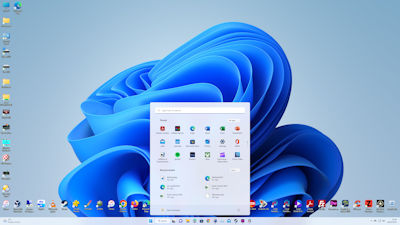
 |
Windows Guide |
Update: 20 Jan 2023
The desktop is what you see when you load Windows and where you would work from such as running applications and managing your files via Explorer.

Windows 11 desktop has all the features including a backdrop, start menu, task bar, toolbars, system tray and so on. There are some subtle differences though.
The Start button has moved to the bottom center of te screen and when you click on it , it displays a white window icon and when you click on it. The most common programs appear as icons, and if you want to see all programs, just click on the All Apps button at the top right. You can search for programs in the 'Type here for search' box or the search box in the taskbar.

When you first login to Windows, you get the new deskop above. The Windows theme which consists of the Default Windows backdrop of an blue image in the center. Any windows are rounded and by default only one icon, the Recycle Bin, is shown You can get the other icons such as Computers, Network, User File's and Control Panel via the Display Icon settings.. Right click the desktop, select Personalise, select themes and click the Desktop icons settings link.
![]()
To add the new Microsoft Edge browser icon, right click the desktop, select New, Shortcut and enter ""C:\Program Files (x86)\Microsoft\Edge\Application\msedge.exe" --profile-directory=Default" and enter the name Microsoft Edge.
The Quick Launch area is shown by default, and it will contain icons for Search, Chat, File Explorer, Edge and Microsoft Store icons. Other icons can be added or removed from this area by dragging the icon to or from the Quick Launch area. If more than three icons are available, clicking the >> arrows will reveal the others.
In Windows the system tray area can become quite full with icons, some you can turn off via the properties or preferences of that program, if you get a lot of icons, Windows will auto-hide some of them less used icons for you. They can be revealed by clicking on the up ^ arrow.
You can change other properties of the desktop via the Personalisation control panel where you can select the desktop background, colours, sounds, screen saver, desktop icons, and mouse pointers. The screen size can be changed via a seperate Screen resolution option.